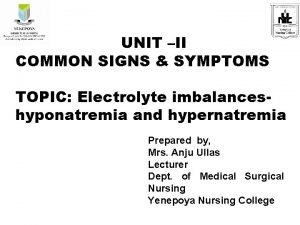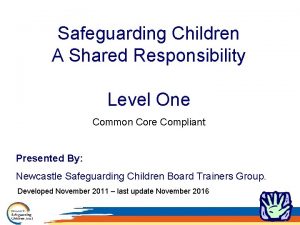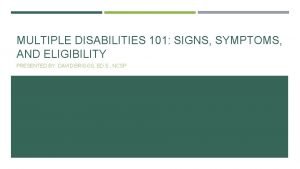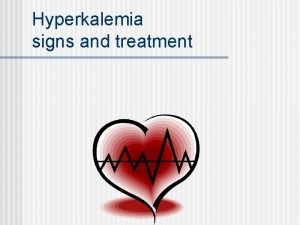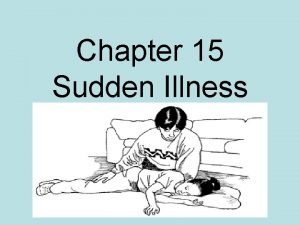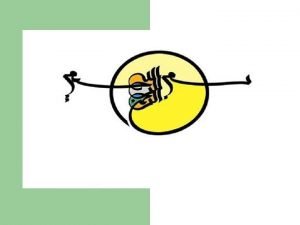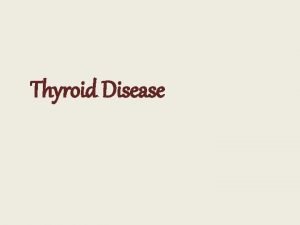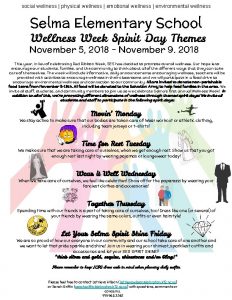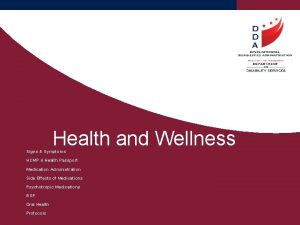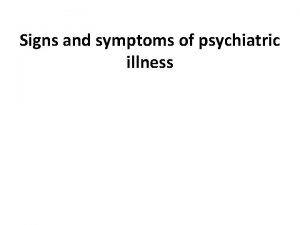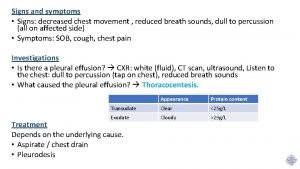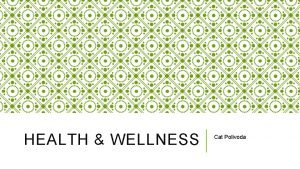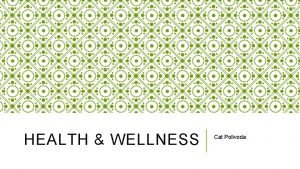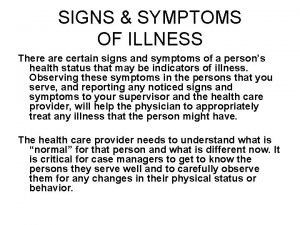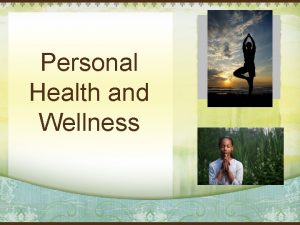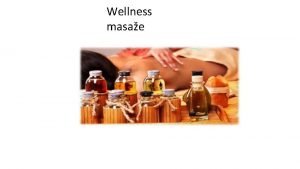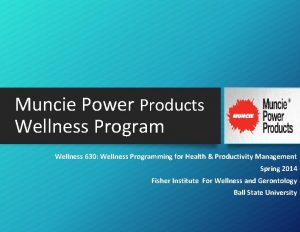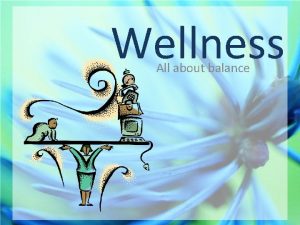Health Wellness and Safety Signs and Symptoms of























- Slides: 23

Health, Wellness and Safety

Signs and Symptoms of Illnesses • • • Fever Lack of energy Difficulty breathing Persistent cough Severe headache and dizziness • • Prolonged diarrhea Constipation Vomiting Anything else that is not typical of the child

Childhood Immunizations • Communicable diseases – Diseases that can be passed from one person to another – Example: Chicken pox • Immunizations can prevent and protect from communicable diseases

Childhood Immunizations • The child is given a vaccination (shot or other form) of a weakened small amount of the disease. • The body then will build up a resistance to it. • Usually given at the age of 2, 5 and 12 years old. • Childcare centers, preschools, and public schools require children to be caught up on their immunizations prior to enrollment.

Side Effects of Immunization • • • Low-grade fever Irritability Tenderness Redness Swollen in the sight of the vaccination

Types of Immunizations • • • MMR – Measles, Mumps, Rubella DPT – Diphtheria, Tetanus, Pertussis HIB – H. influenza type B Hepatitis B Varicella (Chicken Pox)

Types of Immunizations • • • Polio Pneumococcal Hepatitis A Influenza (flu) shot every year Tetanus and Diphtheria – Every ten years

Basic First Aid Practices • Bumps and Bruises – Apply cold for about 10 minutes. – Elevate • Minor Burns – Place burn under cold water – Do not apply ointment or lotion – Keep it dry and clean – Never pop the blister

Basic First Aid Practices • Minor Bleeding – Apply direct pressure – Dry the wound – Apply a medicated ointment – Cover with bandage

Basic First Aid Practices • Nosebleeds – Sit or stand, leaning slightly forward – Apply pressure to the lower part of the nose by squeezing for about 10 minutes. – Release your fingers to see if the bleeding has stopped. – Repeat if necessary.

Basic First Aid Practices • Poisons – Call poison control – They will instruct you as what to do

Basic First Aid Practices • Choking – If the child is coughing, encourage them to continue. – Never smack a coughing person on the back. – If they are not making any sounds or breathing, rescue techniques are needed.

Basic First Aid Practices • Insect, Plant Irritation or Animal Bites – Wash with soapy water – Apply medicated ointment. – If it breaks the skin, watch the site for risk of infection.

Basic First Aid Practices • Insect Sting, Splinter, or Minor Puncture – Wash the area with soap and water – Remove the stinger or any other foreign object. – Apply cold pack to area. – Cover with bandage. – Watch the person and area for any allergic reactions or infections.

Car Seats • Know current state seatbelt and car seat laws concerning children of all ages. • Children under 12 should not sit in a seat where there is an airbag. • The safest place for a car seat is in the center, back seat of the vehicle.

Car Safety • Never leave a child alone in the car no matter what age. • Older children can panic and not being able to get out of the car.

Child-Proofing Strategies • Childproofing the house: – The child is protected from possible dangers – The child has freedom to explore without risk of encountering hazardous objects and materials. – Best done before the child learns to first move around (roll, creep and crawl).

Child-Proofing Strategies • Keep children away from: – Candles – Fireplaces – Stovetops – Anything that could cause burning

Child-Proofing Strategies • Water temperature in the house should be set to 110 -120 degrees Fahrenheit. • Place all poisonous substances and medications high on a shelf and locked up. • Keep floors and stairs free of clutter to prevent falls. • Use safety gates on stairs.

Child-Proofing Strategies Place caps over all electrical outlets. Place cords out of reach. Unplug appliances not in use. Place screens and safety latches on all windows. • Use window blinds with safety features. • Keep blind cords away from children. • •

Toy Safety • • • Age appropriate Appropriate for the level of development Engage as many senses as possible at one time Have multiple open ended uses. Non-toxic paint Sturdy construction

Toy Safety • Working parts • Throw away broken toys • Children under 3 should avoid toys that are small or have small parts that can be swallowed and cause choking. • If it fits in a toilet paper tube, it is too small for them. • Purchase washable toys and clean them regularly.

Summary • Recognize the signs and symptoms of childhood illnesses. • Stay on top of the child’s immunizations. • Know basic first aid practices. • Be aware of and follow car safety rules. • Childproof the home. • Choose toys that are fun yet safe to use.
 Divided highway begins sign
Divided highway begins sign Chapter 3 health wellness and health disparities
Chapter 3 health wellness and health disparities Chapter 1 lesson 2 what affects your health
Chapter 1 lesson 2 what affects your health Understanding health and wellness
Understanding health and wellness Period vs pregnancy symptoms
Period vs pregnancy symptoms Signs and symptoms of hyperkalemia
Signs and symptoms of hyperkalemia Icaada
Icaada Trali symptoms
Trali symptoms Signs of shock
Signs of shock Daniel pelka sister
Daniel pelka sister Neuroblastoma signs and symptoms
Neuroblastoma signs and symptoms Signs and symptoms of multiple disabilities
Signs and symptoms of multiple disabilities Severe hypocalcemia
Severe hypocalcemia Hypocalcemia signs and symptoms
Hypocalcemia signs and symptoms Kaexalate
Kaexalate Signs and symptoms of hypokalemia
Signs and symptoms of hypokalemia What causes hemolytic anemia
What causes hemolytic anemia Dka in pregnancy
Dka in pregnancy Signs and symptoms of sudden illness
Signs and symptoms of sudden illness Coma sign
Coma sign Hyperkalemia and muscle weakness
Hyperkalemia and muscle weakness Signs and symptoms of trali
Signs and symptoms of trali Management of hyperthyroidism
Management of hyperthyroidism Ecf volume deficit
Ecf volume deficit





